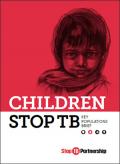Publications - Released in 2016
Childhood TB has been called a "sentinel event" because it indicates failure on two fronts (1). First, it signals an ongoing transmission, since the child likely contracted TB from someone close to him or her and who has likely remained untreated. Second, it indicates a wider failure in the system, since it points to the lack of preventative therapy that could have easily stopped the child from developing TB in the first place (1). Because of the diagnostic challenges presented by childhood TB, symptoms are often missed. Missed or late diagnosis can have catastrophic health impacts for the child and increase the chance of mortality. Suboptimal diagnostic methods, poor screening compliance, and unrealistic treatment guidelines mean that children face even greater barriers to accessing care than adults, making this population even harder to reach. Children often exist as a vulnerable population within already vulnerable populations. Therefore, it is imperative that TB finally be addressed head-on by policy makers, civil society, and health professionals. Not only do children provide the reservoir from which future cases will develop, but continued inaction is costing lives.






